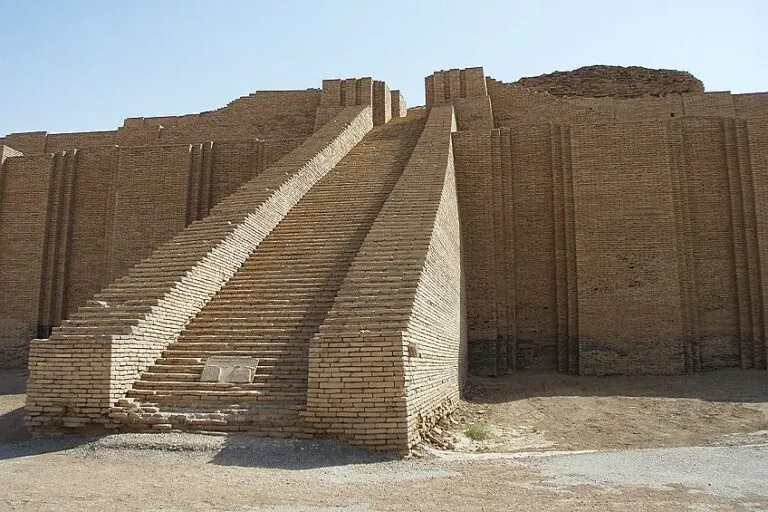Sumerian Tablets – Exploring Ancient Sumerian Texts
Every ancient civilization has a claim to some sort of advancement that put them at the forefront of society at one point or another. However, no civilization on earth has quite as big a claim to the progress of mankind as the ancient Sumerians. The Sumerian people are responsible for the first-ever recorded instances of writing, and even managed to ensure that we’d all be able to see it thousands of years later. What is this form of writing though? What did they write on? How did they develop the language? And more importantly, why did they develop this written language in the first place? Let’s have a look and find out!
Contents
What Are the Sumerian Tablets?
What are the Sumerian tablets you ask? Well, the Sumerian tablets are a collection of stone tablets that have ancient Sumerian texts inscribed upon their surfaces. These texts date back thousands of years and have been used to record a wide variety of things, some of which we still use paper and electronic media to record today.
It’s safe to say that while technology has developed considerably, the human need to communicate and record things has not.
These tablets served the same functions that things like books, invoices, spreadsheets, warning signs, instructional materials, and even memos do today. The key difference is that while we have paper and computers, the ancient Sumerian people used these clay tablets.
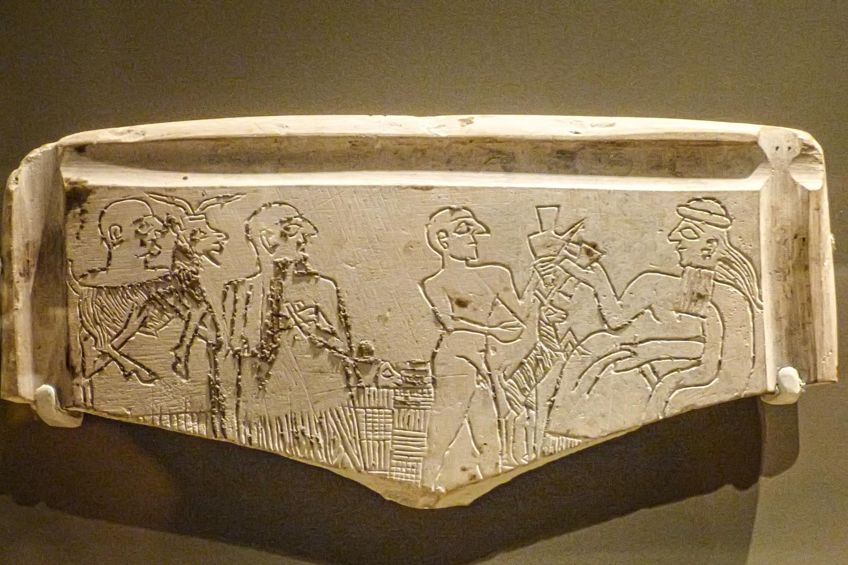 Sumerian Votive Tablet depicting a ruler, a nude priest, and two officials with goats Early Dynastic IIIa Period (2600 BCE); Mary Harrsch, CC BY 2.0, via Wikimedia Commons
Sumerian Votive Tablet depicting a ruler, a nude priest, and two officials with goats Early Dynastic IIIa Period (2600 BCE); Mary Harrsch, CC BY 2.0, via Wikimedia Commons
You could think of the discovery of these tablets as finding an old to-do list or a friendly letter from your great, great grandparents. While it might seem a little antiquated, it’s quite interesting to see that people back then still needed to pass along messages, fulfill orders, write letters of complaints, and ensure that people in the future (like you and I) understood what happened back then.
At the time that some (if not most) of these tablets were created, the ancient Sumerian people were still under the rule of the Akkadians. As a result, Sumerian as a spoken language fell away, making way for the Akkadian dialect. However, it seems that the Akkadians recognized the brilliance of the Sumerians written language and continued to use it long after the verbal Sumerian language fell away.
The ancient Sumerians seemed adamant to record every aspect of their history including the lineage of their leaders, ancient battles, the rise and fall of kingdoms, and even disputes between citizens and businesses on these tables.
The tablets were available in various sizes and weights too, depending on where they were made and the information they were intended to convey. There are also quite a bit of these tablets around. Some are in museums in their country of origin while others have been lent to other countries for display, and all of them have entirely unique information attached to them. Whether the ancient Sumerians purposefully chose clay tablets to write on due to their inherent durability or simply because they did not have the means to produce paper is anyone’s guess, but we do know that we’re happy they chose the former!
What Is Cuneiform?
Cuneiform is the written language of the ancient Sumerian people. This language is considered to be one of the oldest languages in existence. Its origins can be traced back to ancient Mesopotamia, which is now modern-day Iraq. The language itself is considered to be something known as an “isolate”, which essentially means that there is no other language in recorded history related to it.
Cuneiform is believed to have originated in the year 8000 BCE, and since then had been developed even further by the ancient Sumerian people. Originally, the language consisted of pictographs that communicated aspects of what the writer was about with little symbols in between indicating how these core concepts were related to one another.
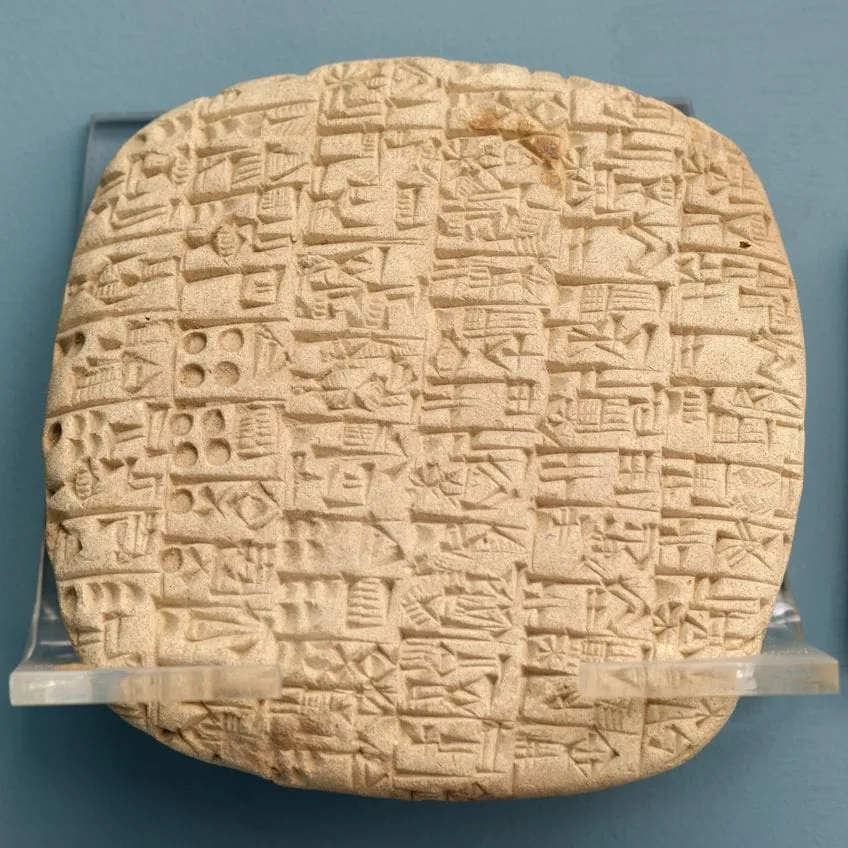 Six-column Sumerian economic tablet mentioning various quantities of barley, flour, bread, and beer (c 2500 BCE); © Marie-Lan Nguyen / Wikimedia Commons
Six-column Sumerian economic tablet mentioning various quantities of barley, flour, bread, and beer (c 2500 BCE); © Marie-Lan Nguyen / Wikimedia Commons
However, as time went on the ancient Sumerians developed the language even further so that the writings could communicate more intricate concepts. This evolution saw the pictographic nature of the language subside to make way for wedge shapes that could be interpreted much in the same way that signage or common memetic symbols are today.
The word “cuneiform” is a relatively modern term that was coined in the late 1700s and translates to “wedge”, which seems appropriate considering how the markings on these tablets would look to the layman. Further changes were made to the language as time went on, and just as with English and other languages, things like shorthand references and common understandings came into play.
Why was cuneiform made in the first place? This might seem like a silly question considering that at some time or another, every civilization in existence required written language.
In the case of the ancient Sumerians, the reason was purely economic. Cuneiform allowed business owners and their clients to communicate effectively, especially if they were far away from one another. In the context of the aforementioned, if you needed to send an order to a client in another village, you could send a clay tablet with your courier detailing the contents of the delivery and the quality that was sent. These clay tablets were often sealed in a clay envelope that could only be opened by presenting a token that matched the seal on the clay envelope. Pretty neat system, right?
Cuneiform Numbers
Where there’s language, arithmetic is never far behind. As you can imagine then, it didn’t take long for the ancient Sumerians to develop a system of numbers through which they could keep track of stock and finances. They would often use the same symbols that they used on seals to represent different amounts of livestock, produce, vegetables, or more valuable things like metal ore.
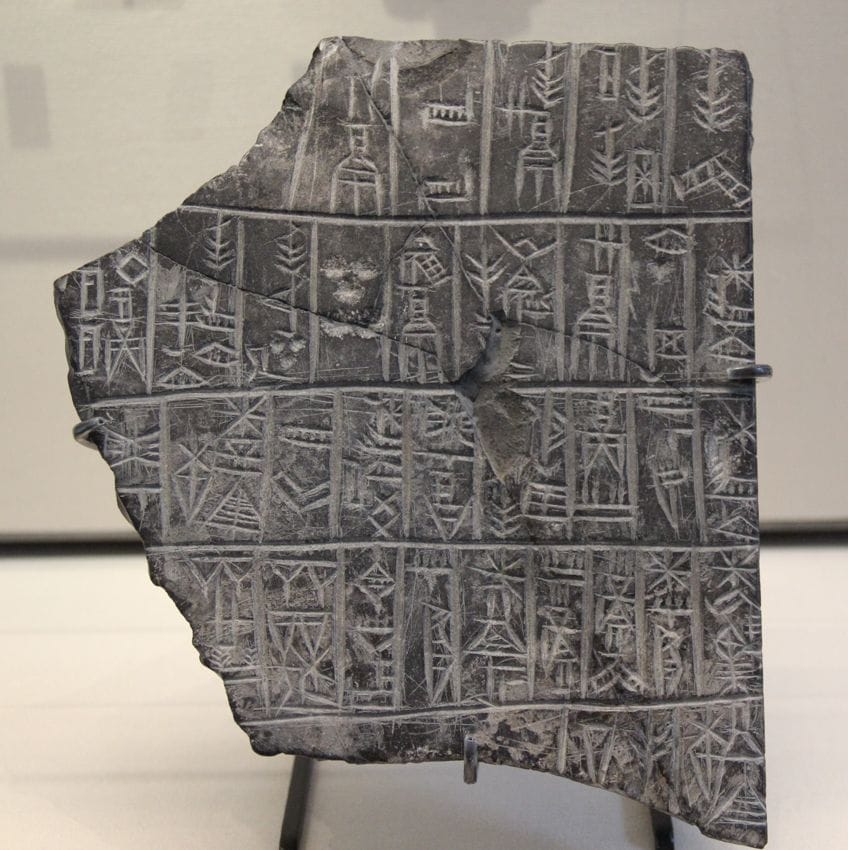 Sumerian Cuneiform Stone Tablet (2900 – 2340 BC); Gary Todd, CC0, via Wikimedia Commons
Sumerian Cuneiform Stone Tablet (2900 – 2340 BC); Gary Todd, CC0, via Wikimedia Commons
Having a numerical system is pretty useful, even today. This allowed merchants and other business people to keep track of things on a larger scale, which allowed them to expand their businesses by taking on new clients. This led to an increase in trade and production of goods, which put the ancient Sumerian people in a league of their own.
Notable Ancient Sumerian Texts
There are quite a bit of ancient Sumerian texts that were discovered in remnants of Mesopotamian society, and a few of them have risen to prominence either due to their impressive state of preservation or because of their contents. Here are a few of the most interesting ancient Sumerian texts found to date and what their contents are.
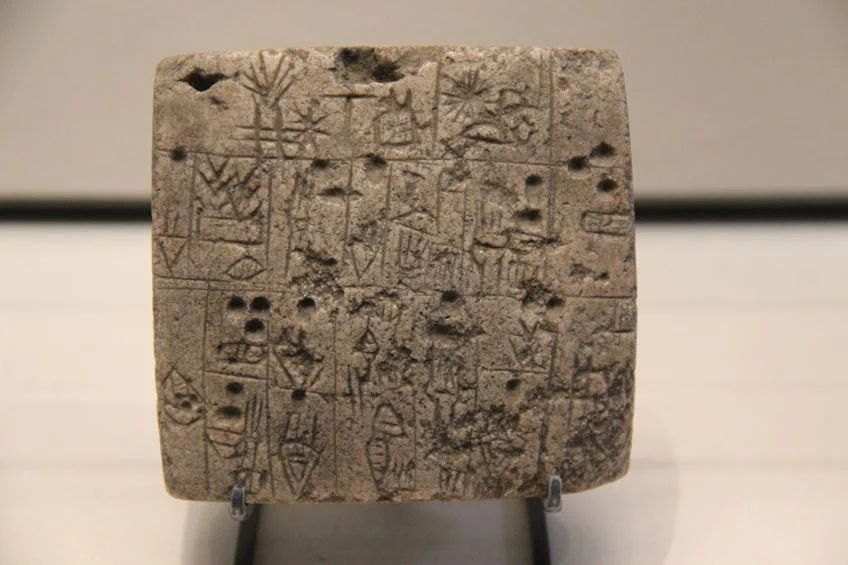 Sumerian Cuneiform Stone Tablet (2900 – 2340 BC); Gary Todd from Xinzheng, China, CC0, via Wikimedia Commons
Sumerian Cuneiform Stone Tablet (2900 – 2340 BC); Gary Todd from Xinzheng, China, CC0, via Wikimedia Commons
The King’s List
We mentioned previously that the ancient Sumerian people took great pride in recording the order of succession of their leadership, much the same way we do today. After all, if you don’t know what types of leaders you had before, it can make choosing new ones a bit challenging. It’s for this reason that it’s believed the king’s list was created. The Kings List, as the name suggests, is a list of rulers who governed one of the oldest Mesopotamian cities.
According to researchers, the list contains a bit of fact and fiction that have been mixed together. According to the text, one leader lived for nearly 42,000 years, which is improbable, to say the least.
However, leaders puffing up the length and quality of their rule is nothing new, even in modern society. Interestingly, it seems that the ancient Sumerians were not biased against female rulers. According to the text, a city-state known back then as “Kish” was once ruled by a woman. The text states that once a king fell, a woman who was previously an innkeeper took reign of the city and proceeded to rule for approximately 100 years. No glass ceiling in ancient Mesopotamia!
Stele of the Vultures
It’s no secret that our ancestors took great joy in warring with one another. The ancient Sumerians were no different, and according to researchers were at constant war with one another throughout the existence of their society. Much like the Greeks, ancient Sumerian society consisted of several city-states, all of which were vying for monopoly over the region. One such battle from ancient Sumerian tablet translations details the conquest of a king called Eannatum of Lagash who went to war with and subsequently defeated the kingdom of Umma due to a dispute over where their borders ended.
This happened back in 2450 BCE, and it would seem that king Eannatum was quite chuffed by his victory.
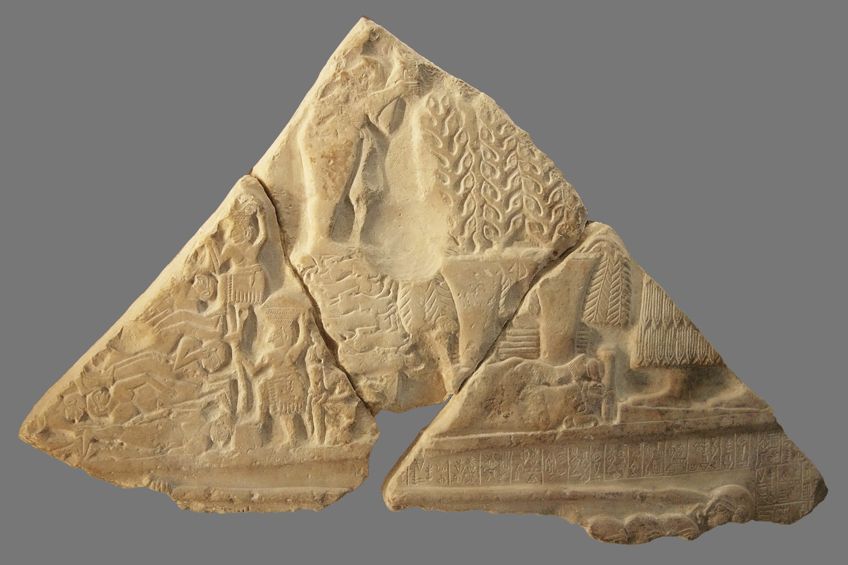 Fragment of the Stele of the Vultures (2450 BC); Eric Gaba, Wikimedia Commons user Sting, CC BY-SA 3.0, via Wikimedia Commons
Fragment of the Stele of the Vultures (2450 BC); Eric Gaba, Wikimedia Commons user Sting, CC BY-SA 3.0, via Wikimedia Commons
How do we know this? Well, he commemorated his victory by commissioning a limestone tablet that has come to be known in the modern day as “the steel of the vultures”. This tablet shows vultures feasting on the corpses of their enemies, which is believed to be an assertion of the dominance of the era. According to other Sumerian tablet translations, he then went on to conquer many more of the city-states but failed to gain the ultimate monopoly.
Banquet Beer Drinking
Whether you’re a fan of having the odd drink or staying away from ale entirely, the ancient Sumerians are well known for their proclivity towards alcohol. As a matter of fact, it’s widely believed that the ancient Sumerian people were the first ones to ever brew alcohol in large quantities for the sole purpose of enjoyment. This tablet depicts several ancient Sumerian people having a ball of a time at what appears to be a banquet of some sort.
One would think that the ancient Sumerians would be expert brewers considering they were brewing since the fourth millennium BCE, but researchers have stated that the Sumerian drink of choice was an ale so thick that it had been drunk through a filtered straw.
We suppose that tastes change over time and if the ancient Sumerians enjoyed their ale that’s all that matters! On the other hand, it is believed that their drink of choice contained much more nutrients compared to alcohol brewed today. Texts have revealed that they believed the brew was good for the heart and liver. In fact, the ancient Sumerians had a goddess of brewing alcohol called “Ninkasi”.
A Nation Reliant on Trade
One of the most widely known facts about the ancient Sumerian people is that they were heavily involved in trade throughout the ancient world. This is due to a number of factors, but primarily because the area they occupied was largely devoid of natural resources like wood and usable stones like flint. These Sumerian clay tablets show the ancient Sumerian people walking along a trade route with livestock, likely either returning from what appears to be a successful trade or ambling along to sell their goods at a market.
The ancient Sumerians were well known for trading far and wide, on land as well as on sea.
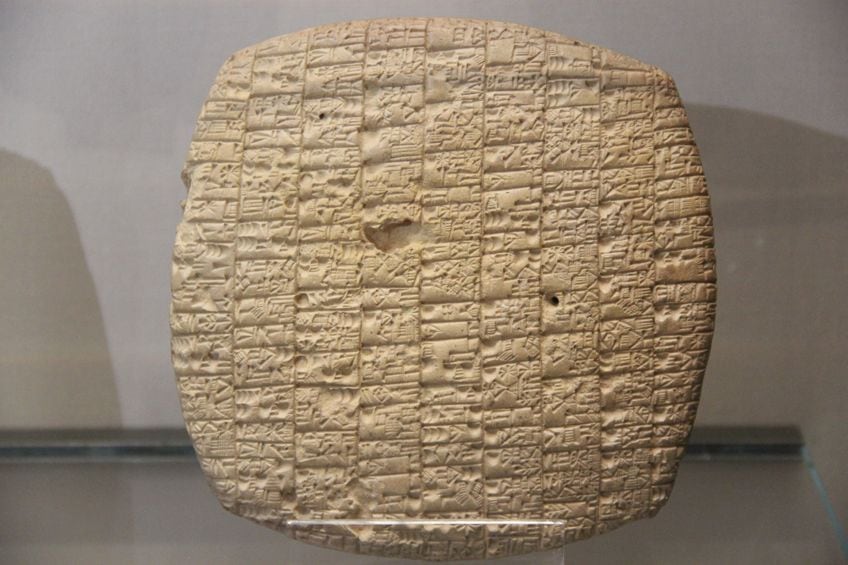 Sumerian Cuneiform Clay Tablet from the Archaic Period of Sumer (2900 – 2340 BC); Gary Todd from Xinzheng, China, CC0, via Wikimedia Commons
Sumerian Cuneiform Clay Tablet from the Archaic Period of Sumer (2900 – 2340 BC); Gary Todd from Xinzheng, China, CC0, via Wikimedia Commons
It was pretty common for their people to travel for months on end to sell their goods or trade for valuable resources that could not be found in their region. One of the most notable trade partners of the ancient Sumerians was the Dilmun, as they were one of the only purveyors of copper in the region, especially in large enough amounts to justify the journey. It’s noted that the ancient Sumerians were particularly fond of the mineral known as Lapis Lazuli, a blue mineral that they would often use to decorate their homes and belongings, and in the creation of jewelry.
How much did they like Lapis Lazuli you ask? They were willing to travel 2,221 km from what is now modern-day Iraq, all the way to what is now Afghanistan.
Where Were Ancient Sumerian Tablets Discovered?
As we mentioned previously, many Sumerian tablets have been discovered over time, but some of the earliest examples of the oldest known tablets were uncovered in Uruk. Uruk is where modern-day Iraq is currently located, but this doesn’t mean that there aren’t other places around the world where these tablets have been discovered too. However, Uruk is where the ancient city of Mesopotamia was once located, so it makes sense that the majority of the ancient clay tablets were found here. It is believed that the clay would have been inscribed upon when the clay was still wet, as it would have been harder to etch into the tablets once they had dried completely.
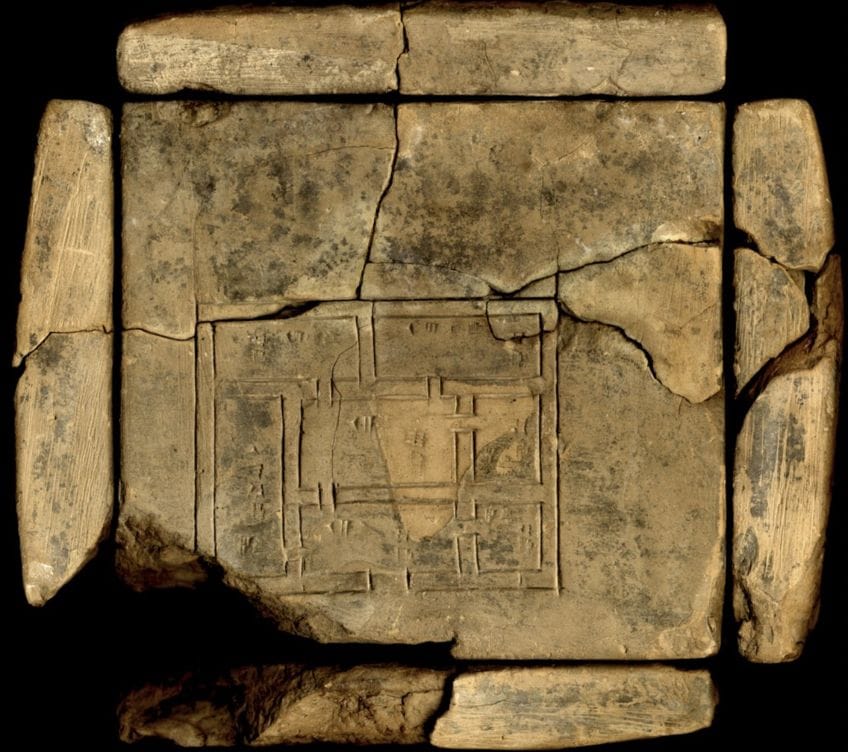 Clay tablet with a house plan, from Umma, Ur III period(ca. 2100–2000 BC); Unknown Sumerian, Public domain, via Wikimedia Commons
Clay tablet with a house plan, from Umma, Ur III period(ca. 2100–2000 BC); Unknown Sumerian, Public domain, via Wikimedia Commons
In recent years there have been massive quantities of Sumerian clay tablets discovered in the area where Uruk once resided. Ashurbanipal, an Assyrian king was discovered as having an entire library full of clay tablets that contained all sorts of information about the Sumerian society, ranging from trade agreements to finances, and even stories and personal letters. The most incredible thing about the tablets discovered in the library is that nearly all of them were perfectly preserved, and not fragmented or damaged like those found elsewhere.
It is estimated that the number of texts discovered in the library is around 30,000, all of which can be found in the British museum where they are studied and restored.
The texts covered a wide variety of things. There are instances of magical, and medical knowledge, lexicons, and legends found in the text. It seems that king Ashurbanipal was intent on collecting and documenting everything that had happened and would happen during his rule, and took advantage of his position in order to do so.
Now that you know what the ancient Sumerian clay tablets are, what Cuneiform is, what some of the most interesting examples of them have to say, and where these tablets were originally found, it’s time for you to get out there and put your newfound knowledge to the test. There are several ancient societies that contributed to our understanding of the world around us, but the ancient Sumerians were among some of the most notable in recorded history.
Frequently Asked Questions
What Did the Sumerians Write On?
Sumerians did not have paper or papyrus, so what did Sumerians write on? The Sumerian people used to write on half-dried stone tablets in a language that has come to be known as Cuneiform. Cuneiform is a pictographic text that eventually evolved into a written language resembling wedges.
What Is the Oldest Known Written Language?
There are thousands of languages in the world, but have you ever wondered what the oldest known written language is? According to experts, the oldest known written language is ancient Sumerian, also known as cuneiform.
What Is the Ancient Sumerian Language?
Ever wondered what the ancient Sumerian language was? The ancient Sumerian language is known as cuneiform. This language was their chosen written language, but their spoken language was Akkadian due to the Akkadian rule in the region.
What Is a Cuneiform Tablet?
The ancient tablets of the Sumerian people are known as cuneiform tablets. A cuneiform tablet is an ancient etched tablet that was used to record information by the ancient Sumerian people. They were used to record stories, inventory, revenue, and even personal letters!

I am deeply passionate about history and am constantly fascinated by the rich and complex stories of the past. As the editor-in-chief of learning-history.com, I have the opportunity to share this passion with a wide audience through the creation and distribution of engaging and informative content about historical events, persons, and cultures. Whether it’s through writing articles and blog posts or creating videos or podcasts, I strive to bring the past to life in a way that is both accurate and enjoyable. My expertise in history, combined with my strong writing and communication skills, allows me to effectively communicate complex historical concepts and make them accessible and interesting to a wide range of readers. I am truly grateful for the opportunity to share my love of history with others through my work on learning-history.com.




